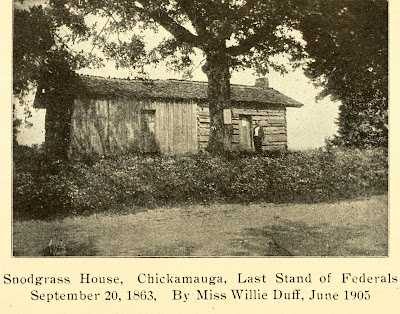Little Dreamed of the Horrors of War: A Civilian’s View of Chickamauga
In 1891, Henry O. Harden, editor of the Fairfield-Pickaway News and veteran of the 90th Ohio Volunteer Infantry, visited Chickamauga battlefield. While visiting the sites where his regiment fought 28 years before, Harden sat down and had a conversation with Mary J. (Snodgrass) Merciers. At the time of the battle, 19-year-old Mary lived on the farm of her father George W. Snodgrass and the family house served as General George H. Thomas’ headquarters during the battle for Snodgrass Hill on September 20, 1863. Harden recorded her comments which he later published in his newspaper and in his regimental history of the 90th Ohio Volunteer Infantry.
Living off here in the country, we
little dreamed of the horrors of war. I was the oldest of six children. My
father was greatly troubled when the battle opened the first day as he could
not imagine what the Yanks would do with him as there had been none in that
part of the country before and he had no correct idea as to what they were. I
told him to stay at home but some of the family wanted to go and hide. Finally,
he said he would stay right there let the consequence be what it might.
About this time, a Confederate cavalry
officer rode up with a sack of meal and asked me to bake him some bread. I told
him it was a poor time to be thinking of baking. He said to me to bake it and
if he was not back in an hour, eat our ourselves or give it to some damned
Yankee. I baked the bread but the officer did not call for it, but a Yank did.
Dinner time came and all was confusion. I said I was going to eat some dinner.
So myself and my stepmother and the children sat down at the table on the porch
and finally persuaded father to do so.
We ate
our dinners and in the afternoon the fighting began. We were ordered to leave
for a place of safety. We went to Mrs. Mulled’s house whose husband was in the
Confederate army. This was about a quarter of a mile from our house and here we
stayed the first night. Things became too hot and on Saturday we all went to
Mrs. Cooper’s whose husband was also in the Confederate army. Here we spent the
second night and on Sunday we were obliged to move again, going about a mile
back into the woods. Here we spent Sunday night. At this time, our party
consisted of 63 women and children with no male protectors around log fires
with nothing in the world except what we had on our backs.
I
afterward went back to the house but found bedclothes and everything torn up
for bandages for the wounded. When the battle commenced and before we left our
house for the last time, men were brought in bleeding as if they had been cut
with a butcher knife. Our house was taken for a hospital and was also General
Thomas’ headquarters. I did not mind seeing this at the time but I could not
bear it now. I could have walked all over the field near our house on dead men.
When the Yankees were beaten back, they went in great confusion, throwing their
knapsacks, cartridge boxes, and some would bend their guns by striking them
against a tree.
The
Yanks were buried in a square hole dug in the ground. A row was put in and then
they were laid across the other way. When they were dug up and taken to
Chattanooga, they were placed in rough boxes and hauled away. The first Yankee
money I got was a 25-cent shinplaster by giving a soldier a bucket of water. We
did not go back to our house to live for two years after the battle. The first
pair of shoes I had after the battle I got by the sale of bullets and other
things which I gathered up on the battlefield and sold in Chattanooga.
Source:
Harden,
Henry O. History of the 90th Ohio Volunteer Infantry in the Great
War of the Rebellion in the United States, 1861 to 1865. Stoutsville: Press
of the Fairfield-Pickaway News, 1902, pgs. 178-180












Comments
Post a Comment